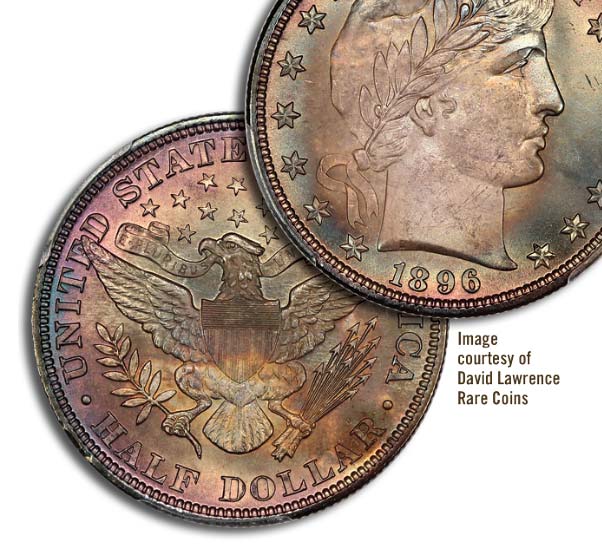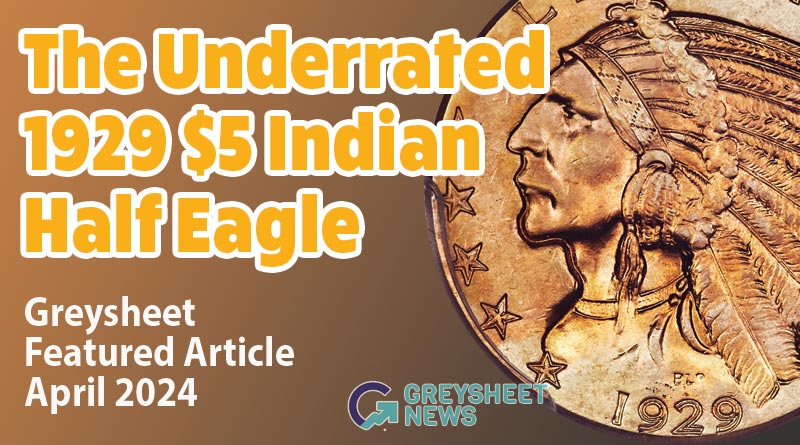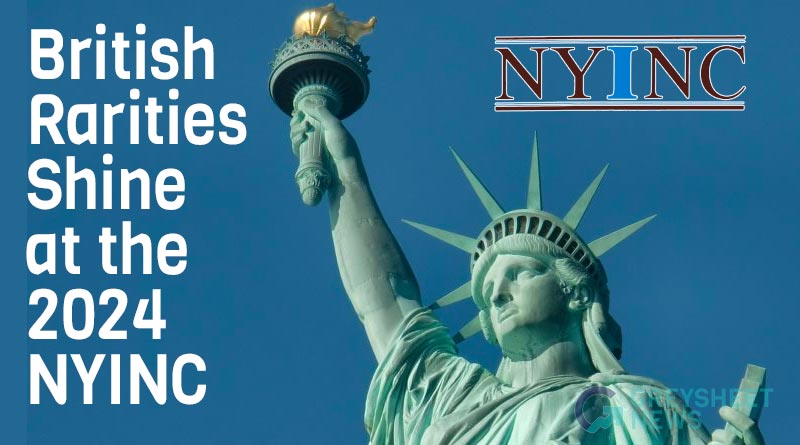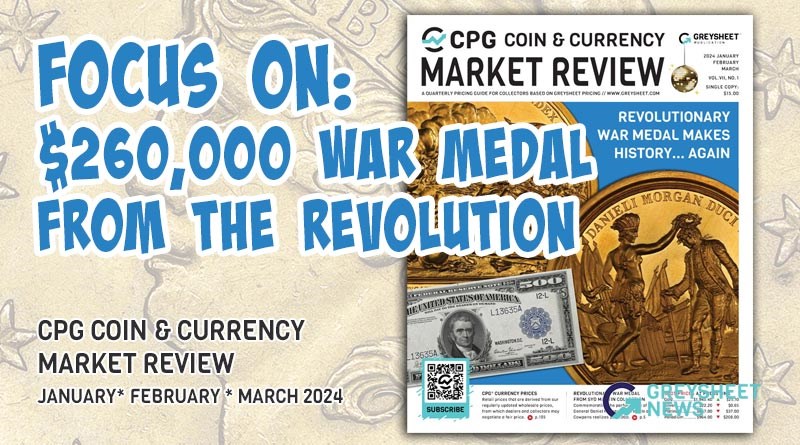SERIES ANALYSIS: Building a set of Barber halves in MS64-66 grades (Part 2)
The current topic is MS64 to MS66 grade halves, choice to gem pieces, but not the highest certified of respective dates.
This is the second installment of a series on collecting Barber coins. The first part was about assembling a set of Barber half dollars that grade from XF40 to AU55. The current topic is MS64 to MS66 grade halves, choice to gem pieces, but not the highest certified of respective dates.
A theme here is that MS64 to MS66 grade classic U.S. coins are often better values for collectors than coins that are among the highest certified by PCGS or NGC for individual dates. When I was a kid collecting coins, a date referred to the combination of the year and the location of the mint that produced the respective coin. For example, in regard to the year 1906, there are four dates of Barber half dollars: 1906 (Philadelphia), 1906-Denver, 1906 New Orleans and 1906 San Francisco.
Although few Barber halves in the whole series grade MS67 or higher, auctions, media attention, registry sets, and conversations among collectors, have resulted in so much attention being given to superb gems that choice to gem grade Barber halves have been overshadowed. It is important to think about the aesthetic qualities and market levels of MS64 to MS65 grade Barber halves. After all, the number of collectors who can afford coins valued in the $1,000 to $10,000 range is much greater than the number who can afford coins in the $10,000 to $100,000 range.
In the context of series that began in the 19th century, the most expensive Barber halves are not all that expensive. In mint state grades generally, the 1896-O and the 1904-S are key dates. In MS64 to MS65 grade, the semi-keys are the 1893-S the 1901-O, the 1901-S, the 1904-O and the 1907-S. The 1897-O and the 1900-O are close to qualifying as semi-keys in MS64 to MS65 grades.
Additionally, there are better dates that are not semi-keys but are worth considerably more than the least scarce dates in the series. Although the least scarce dates are often called ‘common dates,’ no Barber half is really common in MS64 and higher grades. Survivors of most dates in the series, however, are common in the AG03 to Fine-12 grade range.
In all grades, the 1892-Micro ‘O’ is extremely rare. Even so, this is an odd mint error. Generally, collectors of Barber halves ignore the 1892-Micro ‘O’!
In grades below MS66, a complete set of Barber halves is a very realistic objective, though this objective is not often mentioned in the media. Over the last fifteen years, there has been a tremendous amount of media coverage of MS67 and MS68 grade Barber half dollars, especially top-ranked coins in fabulous sets.
Many records were set and the room was bustling with excitement when Dr. Duckor’s set was auctioned by Heritage in August 2010 at an ANA Convention in Boston. Maniacal bidding that night was very entertaining.
Curiously, I am responsible for much of the media coverage in dozens of articles in three publications. I focused upon or discussed superb gems in the many amazing sets of Barber halves that have been publicly sold over the last fifteen years. For superb Barber halves, this era was incredible, almost unbelievable.
John Hugon’s set was auctioned in January 2005, Dale Friend’s set in January 2009, Dr. Duckor’s set in August 2010, Gene Gardner’s set in 2014 and 2015, plus the “Greensboro” set in August and October 2015. Unfortunately, I missed the auction of Dr. Shireman’s set in January 2016, though I wrote a detailed preview of it after viewing his coins. The private sale in 2018 of a superb set of Barber halves to Dell Loy Hansen by the connoisseur who calls himself “Perfection,” and Hansen’s later acquisitions, continued the mania for finest known Barber halves. Each of the just mentioned sets is among the all-time best sets of business strike Barber half dollars ever formed, partly because many of the same MS67 to MS68 grade coins were included in more than one of these sets.
In August 2010, Dr. Duckor’s CAC approved MS67 1904-S brought $138,000, an auction record for a Barber half dollar. In January 2009, Dale Friend’s CAC approved MS66 grade 1904-S half went for $80,500, in the midst of a severe recession. Less than a month earlier, on December 11, 2008, the firm of David Lawrence Rare Coins sold a PCGS graded MS64 1904-S for $19,550. In March 2018, Stack’s-Bowers auctioned a PCGS graded MS64 1904-S half, with a CAC sticker, for $20,400. For a set in MS64 to MS66 grades, the 1904-S would probably be the most expensive purchase, perhaps costing dramatically more than any of the other coins.
In the standard seventy-three coin set of Barber half dollars, fewer than ten coins would cost a collector more than $5000 in MS64 grade. Indeed, MS64 grade coins of a majority of the dates in the set may be purchased for less than $2000 each, and appealing MS65 grade coins of many dates could be found and obtained for less than $2,850 each.
In the grand scheme of ‘mint state’ classic U.S. coins, the costs of collecting Barber halves are not large. Prices realized in January 2009 in the auction of Dale’s set illustrate the point that the long-term mania for superb Barber halves has deflected attention from the reality that MS64 and MS65 grade Barber halves are modestly priced in the context of scarce, pre-1917 U.S. coins.
Dale Friend’s 1898, which is not a rare date, was PCGS graded MS67 and went for $57,500! The current Greysheet bid for a CAC approved MS67 grade 1898 is $37,500 and the collector-retail CPG® value is $45,400.
The current Greysheet bid for a non-CAC MS65 grade 1898 is $2,000 and the Greysheet bid is $2,500 for a CAC stickered MS65 1898 half. Collectors should expect to pay more than Greysheet bid levels if they buy coins privately from dealers. I am now drawing attention to the difference between the MS65 value and the MS67 value for an 1898 half. Fifteen times $2,500 equals $37,500!
In January 2009, the most astonishing result for a half in Friend’s set was the $53,187.50 paid for a 1907-D, which was PCGS graded MS67 and CAC approved. That same coin sold for $25,850 in October 2015 as part of “The Greensboro Collection.”
All along, MS64 grade 1907-D halves have been selling for prices that are small fractions of the value of the highest ranked 1907-D. For example, in March 2019, Heritage sold a PCGS graded MS64 1907-D for $750.
Values of mint state 1907-D and 1906-D halves help illustrate points being made here. Last September, a NGC graded MS64 1906-D realized $840 in an auction at a Long Beach Expo. In April 2019, a PCGS graded MS64 1906-D was auctioned for $780 at the Central States Numismatic Society Convention.
In January 2019, a PCGS graded MS66 1906-D, with a CAC sticker, was sold for $5,875. In that same event, a PCGS graded MS67 1906-D brought $49,937.50. That superb 1906-D was earlier in the Hugon, Gene Gardner, and Greensboro Collections.
For 1906-D halves, PCGS reports a population of fifty-four in MS64, two as MS64+, eighteen as MS65, seven as MS66, two as MS66+, and the just mentioned coin as the sole 1906-D that has been PCGS graded as MS67. NGC reports a census of thirty-eight in MS64, nine in MS65, four in MS66 and zero in MS67. CAC reports a population of twelve in MS64, five in MS65, seven in MS66 and one MS67.
Of course, population data includes multiple counts of some of the same coins. A pertinent point is that there are likely to be several appealing MS64 or MS65 grade 1906-D halves available over the next few years, for modest prices.
For a MS65 1906-D, the current Greysheet bid is $2,000 and the CPG® retail estimate is $2,500. The Greysheet bid for a CAC approved MS64 1906-D is $890 and the CPG® value is $1,140.
Yes, there are collectors who figure that the attractiveness, technical quality and condition rarity of “MS66+” to “MS68” grade Barber half dollars result in these being worth the prices that have been paid for them over the past fifteen years. The purpose here is not to criticize those coins, many of which excite me. The purpose here is to draw attention to relative prices and to raise the point that MS64 to MS66 grade Barber halves may be good values for already interested or potentially enthusiastic collectors in the current market environment.
While it is true that quite a few certified MS67 or MS68 Barber half dollars are truly beautiful, there are some certified MS65 and MS66 coins that are very appealing, too. A coin may have a few hairlines or small marks on Miss Liberty’s face, yet be very attractive. Collectors may enjoy searching for very attractive MS64 to MS65 grade Barber halves.
A set of MS64 to MS65 grade Barber halves, perhaps with a few MS66 grade coins, is a very realistic objective. The least scarce dates are just too easy to find in MS64 grade.
For the vast majority of dates, there are more than a dozen different coins that are certified as grading MS65 or MS65+. Interestingly, 1913, 1914 and 1915 Philadelphia Mint halves are semi-keys in Good-04 to VG10 grades and are difficult to find in MS66 grade. These are nonetheless available in MS64 to MS65 grades.
In March 2019, Heritage auctioned a PCGS graded MS64 1913 for $2,640. PCGS has graded fifty-two business strike 1914 halves as MS64, five as MS64+ and ten as MS65. NGC has graded thirty-six as MS64 and also ten as MS65. While no one would recommend every single certified 1914 half, there are fair number from which to select a MS64 to MS65 grade representative for a set. In January 2019, Heritage auctioned a colorfully toned, PCGS graded MS65 1915 half for $2,640, much less than half of the price that a certified MS66 1915 half would be likely to realize if auctioned in 2019.
Invariably, collectors will obtain coins that have problems or not so apparent imperfections. It does not make sense to obsess about every single coin. For the few coins that must cost more than $5,000 each, it is a good a idea to consult an expert to discuss the positive and negative aspects of individual coins that are being considered.
It is important to keep in mind that MS64 and higher grade Barber halves are scarcer than most collectors and even most dealers realize. For all seventy-three dates, PCGS has graded 3433 as MS64, 138 as MS64+, 1376 as MS65 and 82 as MS65+. These totals include multiple counts of many of the same coins, though do not include extant NGC graded coins. CAC has approved around 594 Barber halves in MS64 and 433 in MS65, as of July 25, 2019.
Some of the least scarce dates account for a substantial percentage of the mint state population totals for the whole series. MS64 or MS64 grade representatives of several of the better dates appear infrequently, surprisingly so. It is a challenge to complete the set, and the process of building a collection of MS64 to MS65 grade Barber halves may be very enjoyable.
©2019 Greg Reynolds
Insightful10@gmail.com

Download the Greysheet app for access to pricing, news, events and your subscriptions.
Subscribe Now.
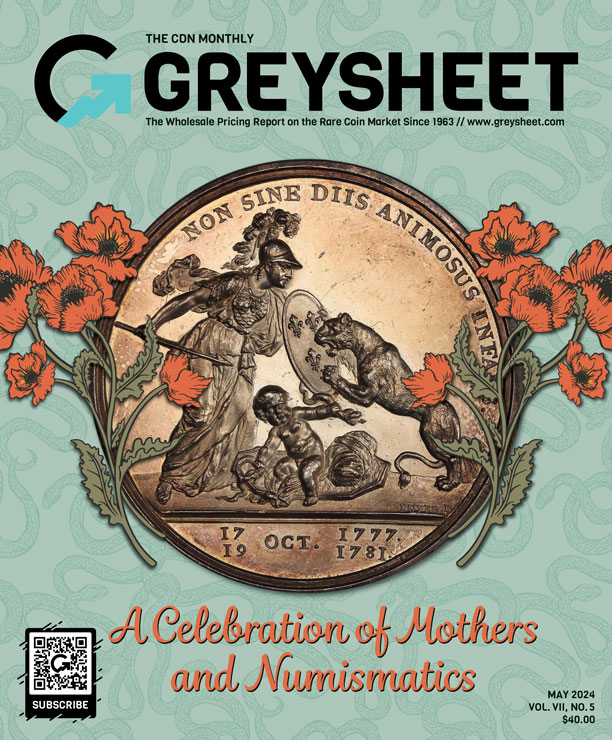
Subscribe to Monthly Greysheet for the industry's most respected pricing and to read more articles just like this.
Source: Greg Reynolds


